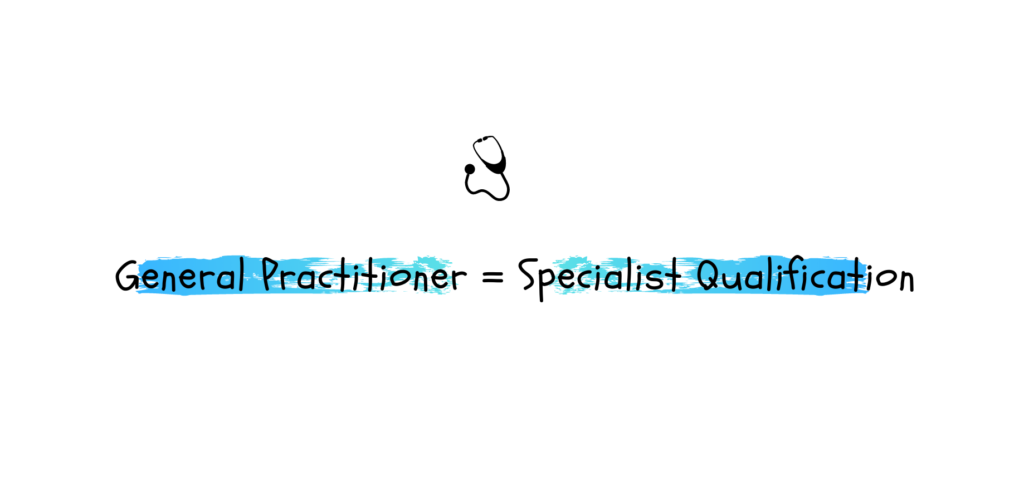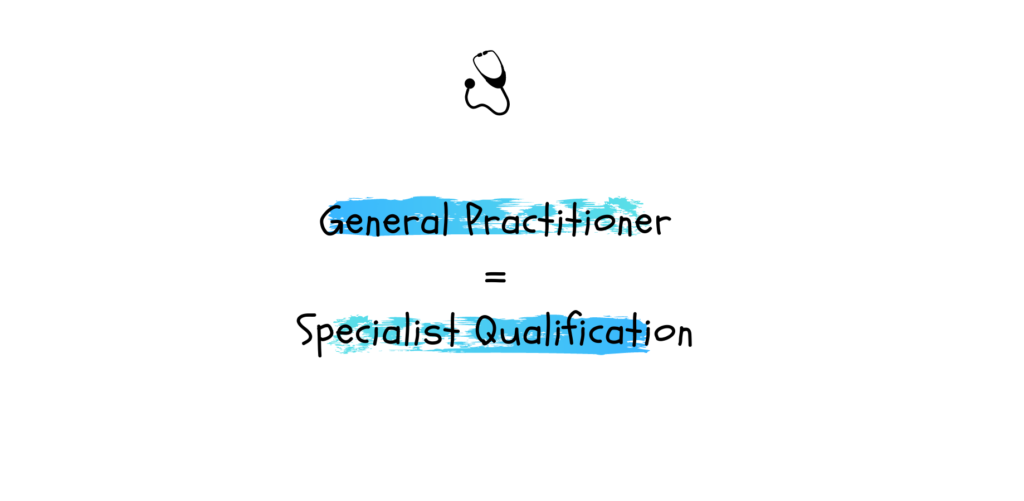Overview
Welcome back everyone!
This weeks article focusses on how to specialise as a doctor in Australia in just two years!
I’m going to be breaking this article into two parts (because there is SO much to cover). Check out part 1 below and stay tuned for part 2 next Wednesday!
Part 1 will cover the following:
Introduction – The Long Road to Specialisation
Let’s Set the Record Straight
Choosing a Training College – RACGP vs ACRRM
The AGPT Application Process
National Assessment – the CAAKT
Understanding your CAAKT Score
Final Thoughts
Introduction – The Long Road to Specialisation
Medicine is a never ending journey that begins from the day you decide to apply for medical school until the day you retire. It can be arduous, long and comes with many challenges along the way.
One of the main hurdles that junior doctors are forced to pass through is the inevitable question of what specialty they are going to dedicate the rest of their lives to. This can be a difficult decision when you’ve just entered the workforce as a newly minted doctor. You’ve finally graduated medical school, landed an internship and have started upgrading your dinners to something slightly more nutritious than the two-minute noodles you survived off in university. Life is sweet.
Once they enter the workforce, junior doctors are bombarded with the dreaded question:
“What do you want to specialise in?”

Do they want to become a cardiologist and be an angiogram machine? Do they want to wield the scalpel of a general surgeon? Or ensure that their palliative patients can have a dignified death? The list of options is endless.
Most specialty training programs can take 5-10 years (if not more) to complete. For this reason, the choice of which specialty to pursue is a big one. Most doctors only ever pursue one specialty in their entire career. This is because it takes some much time, dedication, hard work and sacrifice to complete specialty training and qualify as a consultant.
To further add to the conundrum, before embarking on specialty training, junior doctors need to consider their future, especially their life outside of medicine. Do you want to get married or do you have a long term partner? Are you planning on starting a family? Where do you see yourself living in the long term? These external factors can add to the stress of choosing the right specialty.
What if you could do a specialty that would allow you to be a fully qualified, specialist doctor in just 2 years?!
The answer is General Practice.

After you’ve completed you’re junior doctor years (Internship and Residency), you are eligible to begin General Practice Training.
For the remainder of this article, I’m going to enlighten you on how you can complete your specialty training in 2 years via the Australian General Practice Training program.
My main reason for writing this article is to shed light on the actual process of applying to GP training in Australia. Before I applied for GP training, I struggled to find in-depth information on the process and found I was flying blind half the time. So if you’re feeling the same, this article is for you!
Let’s Set the Record Straight
I would first like to preface this article by saying the following:
General practice is an ACTUAL specialty. General Practitioners are specialists in primary and preventative care. You DO NOT just become a GP by graduating medical school. You need to undertake further training and pass exams before you can practice as a General Practitioner.
Alright cool, I’m glad we got that sorted.


Choosing a Training College
In Australia, General Practice Training is overseen by two main colleges.
- Royal Australian College of General Practitioners (RACGP)
- Australian College of Rural and Remote Medicine (ACRRM)
The RACGP has been around the longest, has the most members and tends to be the preference if you are planning on being an urban or outer regional GP. They offer two pathways – general and rural training. The RACGP General Pathway allows you to complete your training in 2 years after leaving the hospital system. The rural pathway takes 3 years.
Within RACGP, there are regional training organisations (RTO’s) which are smaller “branches” of RACGP responsible for administering medical education and pastoral support during your training. These are based geographically and you can see the distribution on this map here.
By comparison, ACRRM is a slightly smaller and newer college with a focus on rural and remote medicine. This is the college to choose if you would like to become a Rural Generalist. The ACRRM pathway is slightly longer and can take 4-5 years depending on your advanced skill.
For the purposes of this article, I will focus on the RACGP pathway, because it is the one I’m most familiar with (and I don’t want to mislead you).

The Australian General Practice Training (AGPT) Application
Once you’ve chosen the right College for you, the next step is to complete an online application to determine your eligibility. This is run by Australian General Practice Training.
There are usually two intakes every year, depending on numbers. The first application opens in March/April and the second (smaller) intake takes place in August/September. You usually apply a year or two before you actually intend to start working in a general practice clinic. E.g. if you wanted to start GP placements in 2023, you would have to apply in 2022 or 2021.
This application is largely administrative. It involves filling out all your personal details and identification documents as well as records of your medical training (i.e. certificate from medical school proving that you are an actual doctor). It can be a bit arduous but which junior doctor isn’t used to a bit of paperwork.
Sometimes you will be asked to provide further documentation to demonstrate your eligibility. To ensure you meet the eligibility requirements, check out the official eligibility rules here.
If successful, you will be sent an email saying you are eligible to progress your application to enter General Practice training (#yay).

Sit a National Assessment – the CAAKT
If you’ve chosen the RACGP as your training college, you will be required to sit a national standardized assessment. This is known as the Candidate Assessment and Applied Knowledge Test (CAAKT). The questions in the CAAKT are based on the competency indicators outlined in the RACGP Competency Profile of the general practitioner at the point of Fellowship.
If you are planning on apply for the GP program, make sure you start saving because the CAKKT requires a cool $725 donation to the RACGP.
This test is administered online (at least during Covid times) and consists of fifty (50) situational judgement questions and twenty (20) knowledge questions. You will have 2.5 hours to complete all 70 questions.
Situational Judgement Test (SJT) Questions
Situational Judgement Test (SJT) questions are designed to test your judgement in a range of different scenarios. This can be anything from professionalism, to medico-legal issues to managing conflicts of interest. These questions are NOT designed to test your in depth knowledge of the management of medical conditions. It is important you read these questions carefully because they will ask you different things i.e. the most appropriate next step, ranking the order of certain actions you would take, the three best options.
Also, SJT questions are marked differently. They are not simply correct or incorrect. You are able to gain partial marks too. For example, if you choose 2 out of the 3 best answers you will get partial marks for that question.
You can check out some sample questions from the RACGP here.
Pro tip: The UK GP Training application is also very similar and they regularly test their candidates using situational judgement questions. You can find some handy practice questions here, here and here.

Knowledge Test (KT) Questions
Knowledge test questions are multiple choice questions which are designed to assess a candidate’s knowledge of acute emergency situations and identify potentially serious conditions. For example, they are unlikely to ask you about the different steroid creams for dermatitis but they will expect you to recognise red flags in a patient presenting with shortness of breath.
The knowledge test questions are there to assess if a candidate is a safe practitioner and has a baseline level of clinical knowledge that they can build upon during their general practice training.
For most junior doctors, this part of the test will not require extra study as the questions involve common scenarios you would have seen in your internship and residency years.
Pro tip: Look at common emergencies that present to general practice across the range of specialties – i.e. surgical, medical, gynaecological, obstetric, paediatric and make sure you understand how to recognise and manage each one. Work on your weaknesses!

Understanding your CAAKT Score
A few weeks after you have completed the CAAKT exam, you will receive an email to show your score. The CAAKT is scored according to centiles. Each 10 centiles are grouped into a band. For example, Band 1 will include all the candidates who scored in the top 1-10% of the CAAKT exam, Band 2 will consist of all the candidates who scored in the top 11-20% of candidates, Band 3 will include all the candidates in the top 21-30% etc.
You will be able to see how many people were in each band across each state and pathway (rural and general).
Depending on your band allocation, the regional training organisation to which you want to apply and the number of positions available, you will be offered a spot to interview for a position.
For example, say you were wanting to apply to the Regional Training Organisation in South East Queensland which has 100 training spots available. Let’s say you scored in Band 4 with 20 other candidates. There was a total of 60 candidates in Bands 1, 2 and 3 combined. This means there was a total of 80 people ahead of you. Using this example, you would be offered an interview with your first preference RTO.
However, if there were 120 people who ranked higher than you, then you will most likely miss out on an interview for your preferred RTO.
Typically, the most competitive locations around Australia are clustered around the eastern seaboard near South East Queensland, New South Wales and Victoria.
Assuming you rank highly enough, you will be offered a spot for your first preference regional training organisation.
More on that next week….

Final Thoughts
So I think that’s enough exam talk for one article. I’m gonna wrap up Part 1 here. I think I’ve bombarded you with enough information already.
Stay tuned for Part 2 next week, which will include more information about the Interview process, How to choose a General Practice clinic, Recognition of Prior Learning and the training process.
In the meantime, if you have any questions, feel free to contact me at askdoctornisha@gmail.com
Share this post!









